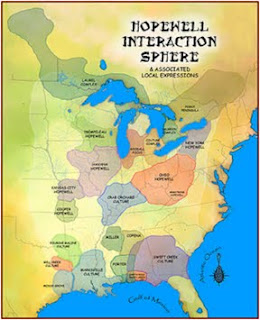 Writing about the First Inhabitants of the Great Lakes Region in North America, and quoting several archaeologists and anthropologists who have worked in and written about the area, we find: “Another group of Native Americans referred to as the Old Copper tribe also existed in the period between 3000 B.C. to 500 B.C.. The Old Copper tribe frequented the southern shoreline. This area of the Great Lakes had a high content of copper in the soil, which the “Old Copper tribe frequently mined and extracted copper for use in their tool and weaponry manufacturing.” The Old Copper tribe were considered the “first fabricators of metal in the Americas” and relied heavily on hunting caribou, deer, elk and bison for survival.
Writing about the First Inhabitants of the Great Lakes Region in North America, and quoting several archaeologists and anthropologists who have worked in and written about the area, we find: “Another group of Native Americans referred to as the Old Copper tribe also existed in the period between 3000 B.C. to 500 B.C.. The Old Copper tribe frequented the southern shoreline. This area of the Great Lakes had a high content of copper in the soil, which the “Old Copper tribe frequently mined and extracted copper for use in their tool and weaponry manufacturing.” The Old Copper tribe were considered the “first fabricators of metal in the Americas” and relied heavily on hunting caribou, deer, elk and bison for survival. As the Old Copper tribe was nearing extinction, a new indigenous group emerged inhabiting a grand part of Wisconsin, northeast Illinois, northern Indiana, and northern Ohio. This group were referred to as the Red Ocher people who lived between 1000 B.C. and 500 B.C.. Like the Old Copper tribe, the Red Ochers also used an enormous amount of copper to construct “awls, celts, knives, and points.” They also “made flint points, and large ceremonial blades as long as 19 inches in length.”
Artifacts and remnants of Red Ocher Culture have been discovered from eastern Iowa to central Ohio and from southern Ohio to the Manitoulin District of Ontario. Further west and south, artifacts of the Red Ochers have been found in “southeastern Wisconsin, northern Illinois, northern Indiana and the southern half of the lower peninsula of Michigan.
In much of this area, the “Red Ochers were co-occupants with the Old Copper tribe before both eventually became extinct at nearly the same time. Similar to the group before, the Red Ochers were also a group of hunters and gatherers but what makes them unique were their burial rituals and the burial grounds they developed. Anthropologists describe a typical burial site of the Red Ocher as consisting of “flexed burials in pits or ridges of sand, gravel or loess, with powdered red ocher in grave, ‘"turkey tail"’ blades of chipped blue grey flint, rather large lanceolate ceremonial knives of whitish flint and caches of ovate triangulated points.”
As one can tell from their burial rituals, the Red Ochers seem unique to their time and place in using ceremonial blades, marine shell beads; gathered from the lake shores, and copper beads; gathered from the ground to symbolize or represent some type of spiritual affection to accompany the deceased.
Directly following the Red Ochers, were the Early Woodlands peoples who became the dominant indigenous group in the Great Lakes region circa 500 B.C. to about 100 B.C. The Early Woodlands “migrated from southern Illinois along the Illinois River until reaching the western shores of Lake Michigan.” During the spring and summer seasons, they would build temporary dwellings, referred to by historians as sod houses slightly submerged underground. They would use the “bark from cedar, ash, elm, spruce and fir trees,” depending on the area, and from among the Early Woodland peoples, a subculture group developed known as the Hopewell Indians. The Hopewellian Indians existed from “500 B.C. to 700 A.D. and they originated from points further south along the Mississippi River valley.” The Hopewellians were famous for “developing the first trade and commerce system within the Early Woodland era.”
Though the Early Woodland Indians were expert hunters of wild game within the boreal forests, the “Hopewellian brought an abundance of furs and clay pottery from points further south to commence a trading procedure in exchange for copper, fish, and game gathered by the remaining Early Woodlands. As a whole, the Early Woodlands were famous for “constructing elaborate burial mounds over the dead using pottery of fired clay brought on by the Hopewellians.” Thanks in great part to the Hopewellian Indians, new artistic achievements were developing among the Early Woodlands with “the use of clay, copper and the abundance of wood to build long canoes from birch trees with the attempt to spread their trade and commerce to points east of Lake Michigan.”
Unfortunately, the Early Woodlands were never as successful as the Late Woodlands (500 to 1000 A.D.) in terms of trade, travel and the exchange of goods since new technological advances and faster mobility would end up favoring the Late Woodlands Indians by far.
The disingenuousness of comparing such a backward and under-developed people of the Great Lakes region to the magnificent building and accomplishments described for the Nephites, a people with over 1000 years of history before arriving in the Land of Promise, and who developed magnificent cities and highways and a culture equally the finest in history, cannot be excused. Absolutely nothing in the Great Lakes can compare with the magnificent accomplishments of the Nephites, and even the Jaredites before them.
(If you have not already read the last three posts on these comparisons with the scriptural record, you might want to do so for further information)




No comments:
Post a Comment